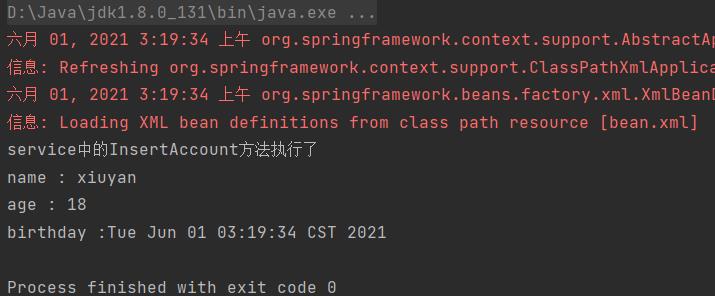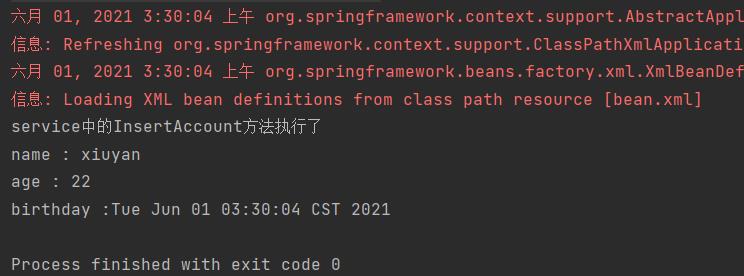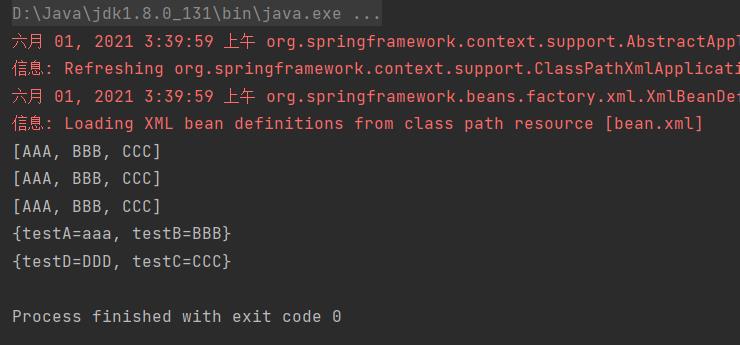Spring 从入门到精通系列 05——Spring 依赖注入的三种方式
Posted Xiu Yan
tags:
篇首语:本文由小常识网(cha138.com)小编为大家整理,主要介绍了Spring 从入门到精通系列 05——Spring 依赖注入的三种方式相关的知识,希望对你有一定的参考价值。
本文针对 Spring 的依赖注入的概述以及三种注入方式进行分析和讲解。

一、spring的依赖注入概述
-
依赖注入:Dependency Injection
- IOC的作用:降低程序间的耦合(依赖关系)
- 依赖关系的管理:以后都交给 spring 来维护
- 在当前需要用到其他类的对象,由 spring 为我们提供,我们只需在配置文件中说明
-
依赖关系的维护:就称之为依赖注入
-
能注入的数据有三类:
基本类型和 String
其他 bean 类型(在配置文件中或者注解配置过的bean)
复杂类型/集合类型 -
注入的方式:
使用构造函数
使用set方法提供
使用注解提供
-
二、使用构造函数
使用的标签: constructor-arg
出现的位置: bean标签的内部
标签中的属性:
- type: 用于指定要注入的数据的数据类型,该数据类型也是构造函数中某个或某些参数的类型
- index: 用于指定要注入的数据给构造函数中指定索引位置的参数赋值,索引的位置是从 0 开始
- name: 用于指定给构造函数中知道那个名称的参数赋值 (常用的)
以上三个用于指定给构造函数中哪个参数赋值 - value: 用于给基本类型和 String 类型的数据
- ref: 用于指定其他的Bean类型数据。他指得就是在 spring 的 IOC 核心容器中出现过的 bean 对象
优势: 在获取bean对象时,注入数据是必须的操作,否则对象无法创建成功。
弊端: 改变了bean对象的实例化方式,是我们在创建对象时,如果用不到这些数据,也必须提供。
<bean id="accountService" class="com.itheima.service.impl.AccountServiceImpl1">
<constructor-arg name="UserName" value="xiuyan"></constructor-arg>
<constructor-arg name="age" value="18"></constructor-arg>
<constructor-arg name="birthday" ref="now"></constructor-arg>
</bean>
public class AccountServiceImpl1 implements IAccountService {
//如果是经常变化的数据,并不适用于注入的方式
private String name;
private Integer age;
private Date birthday;
public AccountServiceImpl1(String UserName, Integer age, Date birthday){
this.name = UserName;
this.age = age;
this.birthday = birthday;
}
}
使用构造函数注入演示:
bean.xml:
<?xml version="1.0" encoding="UTF-8"?>
<beans xmlns="http://www.springframework.org/schema/beans"
xmlns:xsi="http://www.w3.org/2001/XMLSchema-instance"
xsi:schemaLocation="http://www.springframework.org/schema/beans
http://www.springframework.org/schema/beans/spring-beans.xsd">
<!--构造函数注入-->
<bean id="accountService1" class="com.itheima.service.impl.AccountServiceImpl1">
<constructor-arg name="UserName" value="xiuyan"></constructor-arg>
<constructor-arg name="age" value="18"></constructor-arg>
<constructor-arg name="birthday" ref="now"></constructor-arg>
</bean>
<!--配置一个日期对象: 读取这个全限定类名,反射创建一个对象,并且存入IOC容器,可用 now 这个id取出来-->
<bean id="now" class="java.util.Date"></bean>
</beans>
注意: 这个 name 属性值与构造函数中 参数名 相同。
业务层实现类 AccountServiceImpl:
/**
* 业务层实现类
*/
public class AccountServiceImpl1 implements IAccountService {
//如果是经常变化的数据,并不适用于注入的方式
private String name;
private Integer age;
private Date birthday;
public AccountServiceImpl1(String UserName, Integer age, Date birthday){
this.name = UserName;
this.age = age;
this.birthday = birthday;
}
public void InsertAccount() {
System.out.println("service中的InsertAccount方法执行了");
System.out.println("name : "+name);
System.out.println("age : "+age);
System.out.println("birthday :"+birthday);
}
}
模拟表现层 Client:
/**
* 模拟表现层,用于调用业务层
*/
public class Client {
public static void main(String[] args) {
//1.获取核心容器对象
ApplicationContext ac = new ClassPathXmlApplicationContext("bean.xml");
//2.根据id获取bean对象
IAccountService as1 = (IAccountService) ac.getBean("accountService1");
as1.InsertAccount();
}
}
测试结果如下:

三、set 方法注入
涉及标签: property
出现的位置: bean标签的内部
标签的属性:
- name: 用于指定注入时所调用的set方法名称。
name 为实现类中的set方法去掉 set 并把首字母变小写的字符串。
如:setUserName 在bean.xml中 name=userName - value: 用于给基本类型和String类型的数据
- ref: 用于指定其他的Bean类型数据。他只得就是在spring的IOC核心容器中出现过的bean对象
优势: 创建对象时没有明确的限制,可以直接使用默认构造函数。
弊端: 如果有某个成员必须有值,则获取对象是时可能set方法没有执行。
使用 set 方法注入演示:
bean.xml:
<bean id="accountService2" class="com.itheima.service.impl.AccountServiceImpl2">
<property name="name" value="xiuyan"></property>
<property name="age" value="22"></property>
<property name="birthday" ref="now"></property>
</bean>
模拟表现层:
public static void main(String[] args) {
//1.获取核心容器对象
ApplicationContext ac = new ClassPathXmlApplicationContext("bean.xml");
//2.根据id获取bean对象
IAccountService as2 = (IAccountService) ac.getBean("accountService2");
as2.InsertAccount();
}
测试结果如下:

四、复杂类型的注入/集合类型的注入
- 用于给 list 结构及和注入的标签: list array set
- 用于给 Map 结构注入的标签:map props
业务层实现类:
/**
* 业务层实现类
*/
public class AccountServiceImpl3 implements IAccountService {
private String[] myStrs;
private List<String> myList;
private Set<String> mySet;
private Map<String, String> myMap;
private Properties myProps;
public void setMyStrs(String[] myStrs) {
this.myStrs = myStrs;
}
public void setMyList(List<String> myList) {
this.myList = myList;
}
public void setMySet(Set<String> mySet) {
this.mySet = mySet;
}
public void setMyMap(Map<String, String> myMap) {
this.myMap = myMap;
}
public void setMyProps(Properties myProps) {
this.myProps = myProps;
}
public void InsertAccount() {
System.out.println(Arrays.toString(myStrs));
System.out.println(myList);
System.out.println(mySet);
System.out.println(myMap);
System.out.println(myProps);
}
}
bean.xml:
<?xml version="1.0" encoding="UTF-8"?>
<beans xmlns="http://www.springframework.org/schema/beans"
xmlns:xsi="http://www.w3.org/2001/XMLSchema-instance"
xsi:schemaLocation="http://www.springframework.org/schema/beans
http://www.springframework.org/schema/beans/spring-beans.xsd">
<!--复杂类型的注入/集合类型的注入-->
<bean id="accountService3" class="com.itheima.service.impl.AccountServiceImpl3">
<property name="myStrs">
<array>
<value>AAA</value>
<value>BBB</value>
<value>CCC</value>
</array>
</property>
<property name="myList">
<list>
<value>AAA</value>
<value>BBB</value>
<value>CCC</value>
</list>
</property>
<property name="mySet">
<set>
<value>AAA</value>
<value>BBB</value>
<value>CCC</value>
</set>
</property>
<property name="myMap">
<map>
<entry key="testA" value="aaa"></entry>
<entry key="testB">
<value>BBB</value>
</entry>
</map>
</property>
<property name="myProps">
<props><!--prop标签属性只有 key,value 等于标签体内容的值-->
<prop key="testC">CCC</prop>
<prop key="testD">DDD</prop>
</props>
</property>
</bean>
</beans>
注意:list array set 同属于一个list 结构的标签,因此可以使用同一种结构注入,map 结构同理。如:
<property name="myStrs">
<list>
<value>AAA</value>
<value>BBB</value>
<value>CCC</value>
</list>
</property>
<property name="myList">
<list>
<value>AAA</value>
<value>BBB</value>
<value>CCC</value>
</list>
</property>
<property name="mySet">
<list>
<value>AAA</value>
<value>BBB</value>
<value>CCC</value>
</list>
</property>
模拟表现层:
public static void main(String[] args) {
//1.获取核心容器对象
ApplicationContext ac = new ClassPathXmlApplicationContext("bean.xml");
//2.根据id获取bean对象
IAccountService as3 = (IAccountService) ac.getBean("accountService3");
as3.InsertAccount();
}
测试结果如下:

本文针对 Spring 的依赖注入的概述以及三种注入方式进行分析与讲解,如果大家对文章内容还存在一些疑问,欢迎大家在评论区留言哦~
以上是关于Spring 从入门到精通系列 05——Spring 依赖注入的三种方式的主要内容,如果未能解决你的问题,请参考以下文章